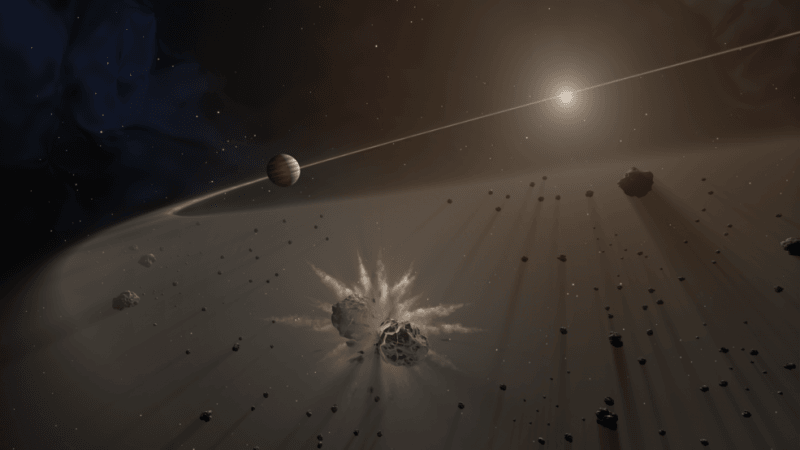
No map exists of the billions of exoplanets hidden in our galaxy. It is a difficult task to find them as they are distant and comparatively less luminous than their parent stars.
ALSO READ: China's FAST radio telescope detects two pulsars during trial run
The latest research states that the giant exoplanets which orbit their parent star at a distance are likely to be spotted around young stars possessing a disk of debris and dust.
This study is so far the largest research on stars having dusty debris disks. Planets which had masses five times greater than Jupiter were mainly analysed by the researchers.
It was concluded that the exoplanets were responsible for keeping the dust and debris in the disks.
"Our research is important for how future missions will plan which stars to observe," said Tiffany Meshkat, lead author and assistant research scientist at IPAC/Caltech in Pasadena, California.
"Many planets that have been found through direct imaging have been in systems that had debris disks, and now we know the dust could be indicators of undiscovered worlds," she added.
ALSO READ: UFO spotted hovering over the Yellowstone Supervolcano [VIDEO]
Meshkat had worked on this study as a postdoctoral researcher at NASA's Jet Propulsion Laboratory (JPL) in Pasadena.
The chances of detecting long-period giant planets for scientists is nine times greater for stars possessing a debris disks than the stars which didn't have such disks.
This was concluded by Caltech graduate student Marta Bryan, who performed a statistical analysis and came up with this result.
Data from 130 single-star systems having debris disks found by NASA's Spitzer Space Telescope were compared by the researchers with 277 star that don't seem to host debris disks. The two star groups aged between a few million and 1 billion years old.
A hundred out of 130 single stars having debris disks were previously analysed by astronomers to detect exoplanets. The other 30 single stars were examined by the astronomers using the W M Keck Observatory in Hawaii and the European Southern Observatory's (ESO's) Very Large Telescope in Chile.
ALSO READ: NASA findings on Mars' seafloor deposits offer clues to origin of life on Earth
No new planets were found by the researchers but the data helped them in characterising the abundance of planets in systems with disks.
The exact reason why exactly giant exoplanets lead to the formation of debris disks was not known by the research. According to the authors, the huge gravity of the giant planets result in the violent collision of small bodies called planetesimals which remain I the disk instead of forming planets.
"It's possible we don't find small planets in these systems because, early on, these massive bodies destroyed the building blocks of rocky planets, sending them smashing into each other at high speeds instead of gently combining," said co-author Dimitri Mawet, a Caltech associate professor of astronomy and a JPL senior research scientist.
Exoplanets are comparatively easier to detect than rocky planets and there is a possibility that some exoplanets have not been found in these systems.
ALSO READ: Giant asteroid TC4 makes closest approach to Earth on Oct 12: LIVE STREAM LINKS
The debris belt present between Mars and Jupiter in our solar system is an outcome of the gas giants, and said to be shaped by the Kuiper belt, Jupiter and Neptune
Astronomers Meshkat and Mawet have analysed many systems possessing two belts, but they are found to be younger than ours by around a billion years, compared to our solar system which is 4.5 billion years old.
The young age of these systems reveal the reason behind the presence of more debris, which is an outcome of the collisions of small bodies compared to our solar system.
A system named Beta Pictoris was also studied and directly imaged by ground-based telescopes. This system was found to possess a debris disk, comets and a confirmed exoplanet. The existence of this exoplanet was predicted by the astronomers even before its confirmation on the basis of the presence and structure of the prominent disk.
ALSO READ: Strange lights spotted in sky over Grand Parkway, Texas [VIDEO]
In another scenario, the existence of two dust belts in a single debris disk point towards the presence of more planets in the system whose gravity maintains these belts, as is the case in the HR8799 system of four giant planets.
The gravitational forces of giant planets nudge passing comets inward toward the star, which could mimic the period of our solar system's history about 4 billion years ago.
Scientists think that during that period, the migration of Jupiter, Saturn, Uranus and Neptune deflected dust and small bodies into the Kuiper and asteroid belts we see today. When the Sun was young, there would have been a lot more dust in our solar system as well.
"By showing astronomers where future missions such as NASA's James Webb Space Telescope have their best chance to find giant exoplanets, this research paves the way to future discoveries," said Karl Stapelfeldt of JPL, chief scientist of NASA's Exoplanet Exploration Program Office and study co-author.














